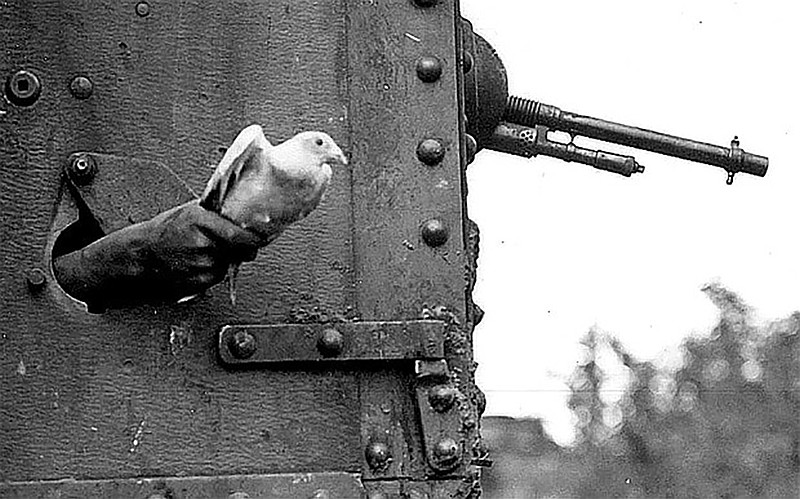Tennessean Alvin York didn't want to fight, but his World War I bravery earned him the Medal of Honor and an enduring reputation as a hero. Now East Tennesseans can trace the story of York's life and legend in an exhibit that opens Saturday at the Museum of East Tennessee History.
Nearly a century has passed since York became arguably WWI's greatest military hero for his actions in France's Argonne Forest on Oct. 8, 1918. "In the Footsteps of Sergeant York" combines new research with WWI artifacts, quotations from York's diary and clips from the Gary Cooper 1941 film "Sgt. York." The exhibit continues at the 601 S. Gay St. museum through July 8.
York became a hero after he and 16 other soldiers were caught in a German ambush behind enemy lines and suffered heavy casualties. An expert marksman who often won shooting competitions back home, he was ordered to silence the machine guns.
When the fight was over, 25 Germans were dead and 132 captured. York's bravery got him promoted to sergeant and eventually earned him more than 40 awards, including the Medal of Honor and French Croix de Guerre.
The making of a legend
Initially the conflict's results were filed in a military report without fanfare. But things changed after Saturday Evening Post writer George Pattullo wrote about the action in April 1919 and singled out the 30-year-old York's heroism.
That article helped begin the legend around York, says Adam Alfrey, the East Tennessee Historical Society operations manager and senior curator. While York was credited with much of the military success, Alfrey says, he always acknowledged the soldiers with him.
"In the Footsteps of Sergeant York" centers on an exhibit from the Nashville-based Museum of the American Military Experience. Included are findings from trips to the Argonne Forest between 2006 and 2009. During the trips, researchers, archaeologists and historians used GPS technology and historic records to trace York's steps.
The East Tennessee Historical Society collaborated with the Tennessee State Parks and the Sergeant York Patriotic Foundation to add items that include objects from York's homeplace, U.S. and German gas masks, uniforms, dog tags, medals and swords. In one corner curators created a German pillbox machine gun nest.
A battle trench - with rats
Visitors entering the exhibit walk through a re-created trench. Built using barn wood topped with sandbags, the 6-foot-tall trench represents those built early in the war, Alfrey says. The real trenches were wet, stinky and occupied by rats, so some large, fake rodents will show up in the museum re-creation.
The most intriguing items include a worn Holy Bible that York carried in the war and gave to sons of a Methodist preacher friend, and one of the German machine guns he's said to have captured. That German Maxim MG 08/15 gun was shipped to Tennessee after the war and displayed at the Fentress County courthouse in the 1920s and 1930s.
With large panels of information, the exhibit traces York's life from his poor, rural upbringing in Fentress County to his postwar legacy. Visitors will be handed a copy of York's draft card, on which he asked not to go to war because he didn't "want to fight."
An expert shot who didn't want to fight
The third of 11 children, the blue-eyed, red-haired York learned to shoot as a child. By 7, he owned his own rifle. He often put food on his family's table by winning marksmanship competitions for prizes of turkey or beef.
As a young man, he earned a reputation as a drinker and a fighter. His life changed dramatically in 1914 when his best friend died in a bar fight. York began to re-examine his life, Alfrey says. In 1915, he converted to the Church of Christ in Christian Union faith, a religion that had strict prohibitions against violence.
When York received his draft notice, he applied for conscientious objector status due to his religious beliefs. His application was denied.
A quote from York in the exhibit illustrated his dilemma. "So you see my religion and my experience told me not to go to war, and the memory of my ancestors jes (sic) plainly sorter (sic) told me to get my gun and go and fight. I didn't know what to do, but I kinder (sic) felt that my ancestors would want to me to do whatever my country demanded of me," he wrote.
Helping his homeland
The exhibit also illustrates York's postwar efforts to improve life for Fentress County, the Cumberland Plateau and Tennessee. Among those efforts was his founding of the Alvin C. York Institute in Jamestown in 1926. He later transferred the school to the state of Tennessee, which continues to operate it as a public high school.
York died in 1964 at age 76. His post-WWI home is now the Alvin C. York State Historic Park in Pall Mall, about nine miles north of Jamestown. Some 250,000 people a year come to York's home, Alfrey says, and his legacy endures after a century.
"I think people are engaged by the story, by the complexity of the man," Alfrey says.
If you go
The Museum of East Tennessee History, in the East Tennessee History Center at 601 S. Gay St., and the exhibit "In the Footsteps of Sergeant York" are open 9 a.m.-4 p.m. weekdays, 10 a.m-4 p.m. Saturdays, and 1-5 p.m. Sundays.
The exhibit opens Saturday and continues through July 8.
Admission is $5 for adults, $4 for senior citizens and free for ages 16 and younger. Sunday admission is free for everyone.
